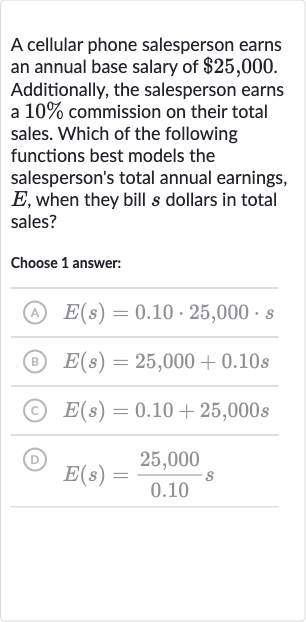AI tutor
Welcome to Bytelearn!
Let’s check out your problem:

A cellular phone salesperson earns an annual base salary of ,. Additionally, the salesperson earns a commission on their total sales. Which of the following functions best models the salesperson's total annual earnings, , when they bill dollars in total sales?Choose answer:(A) (B) (C) (D)
Full solution
Q. A cellular phone salesperson earns an annual base salary of ,. Additionally, the salesperson earns a commission on their total sales. Which of the following functions best models the salesperson's total annual earnings, , when they bill dollars in total sales?Choose answer:(A) (B) (C) (D)
- Understand earnings components: Understand the components of the salesperson's earnings. The salesperson has a fixed annual base salary and a variable component that is a percentage of their total sales. The base salary is , and the commission is of the total sales.
- Translate into mathematical function: Translate the components into a mathematical function.The total earnings will be the sum of the base salary and the commission. The commission is of the total sales , which is represented as . Therefore, the function should add the base salary to the commission.
- Identify correct function: Identify the correct function from the given options.The function should start with the base salary and then add the commission. The commission is calculated by multiplying the sales by . The correct function is base salary commission, which translates to .
- Match with given options: Match the correct function with the given options.Option (A) is incorrect because it multiplies the base salary by the commission rate and sales, which is not the correct representation of the earnings.Option (B) is correct because it adds the base salary to the commission, which is of sales.Option (C) is incorrect because it adds the commission rate to the product of the base salary and sales, which does not make sense in this context.Option (D) is incorrect because it divides the base salary by the commission rate and then multiplies by sales, which is not the correct representation of the earnings.
More problems from Volume of cubes and rectangular prisms: word problems
QuestionGet tutor help
QuestionGet tutor help
QuestionGet tutor help
QuestionGet tutor help
QuestionGet tutor help
QuestionGet tutor help
QuestionGet tutor help
QuestionGet tutor help
QuestionGet tutor help
